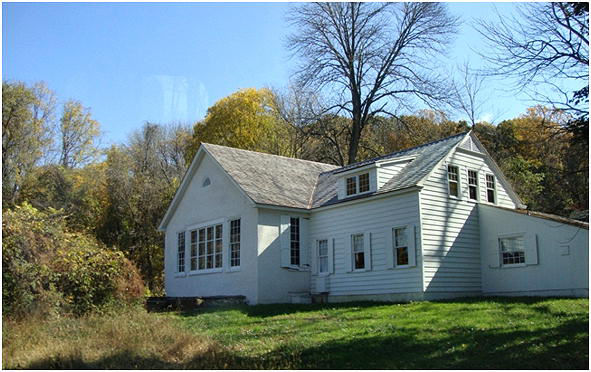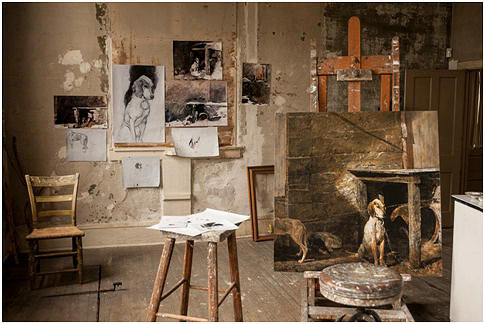![]()
a visit to his studio
Peter Vilhelm Nielsen
Andrew Wyeth passed away in January 2009 after a long life as one of the most famous and beloved painters in America. He was son of N. C. Wyeth, another well-known painter and illustrator of books who lived at the beginning of the last century. Andrew Wyeth’s first solo exhibition with watercolours took place in New York in 1937, and during a few days it was fully sold out. In his whole life he worked with watercolours and egg temperas. He has always been a very popular artist, but also very private. His paintings were often a sort of storytelling about the area and his neighbors, friends and other people in the Chadds Ford, PA, where he lived in the winter and likewise about the area and people from Maine where he lived during the summer. When you look at his paintings you will get a very strong desire to understand the “real” message in his art, and why you feel so attracted to his art.
After his dead, the family decided to donate his studio in Chadds Ford to the Brandywine River Museum, and it was open for the public, almost as it was left by Andrew Wyeth a year before his death. A visit to the studio is therefore a rare opportunity to get a closer understanding of the artist, also because he never opened the studio for anyone when he was working. Even people close to him were not fully aware of his working process.
The building was originally a schoolhouse, and was bought by N. C. Wyeth to serve as a home for other members of the Wyeth family. Andrew Wyeth and his wife Betsy Wyeth moved into the house when they were married in 1940. They stayed in the house until the beginning of the sixties, and Wyeth continued to use the studio in the house almost till he died.

The “schoolhouse” and Andrew Wyeth’s studio in Chadds Ford.
The left part
of the building is the studio with the windows facing north,
as shown by the
shadows. The central part of the house,
the second floor, and the south part
are the living areas,
and the right side of the house is the kitchen.
The studio is located in the northern part the house and is facing free grown vegetation which gives a reflected diffuse light into the studio from the sky and ground. The entry to the house is from the south. There are not many paintings on the walls in the house, but a lot of photos of family and friends. The guide from the museum discussed the photos, and especially a large poster of Botticelli’s Primavera. The guide indicated that Andrew Wyeth’s favorite models were fair-haired with a Nordic look, like the model Helga, but he had also made many beautiful paintings of black models, and even a painting showing a black woman with Helga as the model.
From the hallway there is a look into a reconstruction of the kitchen as it was in the fifties. This is a very cozy room which plays a role in Andrew Wyeth’s introduction of a new painting. He never let people into the studio to look at his work in progress, but he showed the finished painting above the fireplace in the kitchen, and expected visitors to make their comments.
The library is located near the living room and the studio. Here is a whole wall covered with books. Books by favorite artists as Albert Dürer, Thomas Eakins, Winslow Homer and Edward Hopper among many others. (In fact he and his family paid a visit to Homers house and the surrounding area (1) and he met Hopper several times).
A number of film reel cans are also kept beneath the books. Wyeth liked to show films to guests, and he never got tired of showing the silent movie “The Big Parade”. He showed it at least 180 times, and he was in contact with the instructor King Vidor. It is often seen that instructors are inspired by painters, but here is an example where a painter is inspired by a movie. It is rather easy to find a number of situations in the movie which could be the scene of some of Wyeth’s paintings, but it is of course impossible to know if there is a deeper connection between the scenes and the paintings in some of the situations.

Andrew Wyeth’s studio.
It has a very rough as well as private expression,
exactly as he likes to consider his art. Credit Carlos Alejandro.
You enter the studio from the living room. It has a very rough expression with unpainted walls and a large crack in the ceiling. Photos, showing Betsy Wyeth, some friends and Helga as a young woman, are placed on the west wall. It looks as they have been hung on existing nails almost in the order they have been received. The furniture is humble, and looks integrated into the room. The journal Art News was in 1950 allowed to take a photo in the studio(2), and by comparing this photo with the present room it looks like at least one piece of furniture is still in the room. All in all, it is a strong expression of an important working environment with simple furniture and equipment. Probably Andrew Wyeth did not want to change anything during the years because the studio underlined his emotional feelings in the paintings he made. The unchanged rough expression of the studio was perhaps also important to Wyeth because it supports his success in painting and his desire to create a strong message in his art.
Wyeth did look into the abstract quality of his paintings, and he therefore used the large mirror to view his painting from different perspectives as well as turning his paintings upside down during the work.

Wyeth’s studio arranged as it was left before he passed away.
The
sketches and the painting are copies, and they illustrate
the painting of
the tempera “Raccoon” which were made in 1958.
Credit Carlos Alejandro.
Wyeth made pencil drawings, watercolours, dry brush watercolours (3) and egg tempera. The drawings and the watercolours were either made as final paintings or they were preparation for egg tempera paintings. Wyeth made many sketches for one tempera painting. The painting “Groundhog day” is for example based on sixty drawings and watercolours, and “Ides of March” is based on more than thirty related sketches (4, 5). The sketches did sometimes have notes explaining the weather and the light, and they were not only made for the composition of the tempera, they were also made for the study of details in the final tempera painting.
During the painting of an egg tempera, the studio would have looked like the present installation around “Raccoon”. Sketches were everywhere, on the wall and on the floor. Many watercolours, which later were on exhibition, show footprints of Wyeth and his dog, Rattler, as well as splash of tempera painting (1, 6).

Pigments arranged on the window sill.
At least 25 bottles are grouped in
basic colours in
different sections of the window. Credit Carlos Alejandro.
Working with egg tempera requires that fresh mixtures are made several times during the day. Egg yolk is mixed with distilled water, and colour pigment is grinded and added. The arrangement of pigments on the window sill makes it easy for Wyeth to choose the right combination of pigment while he painted, and it also gives a fine overview of the possibilities.
In the autumn of 2012 Brandywine River Museum had an exhibition of watercolours which were related to the studio. This exhibition showed paintings which in some cases were preparations for later temperas or just paintings of the studio, the schoolhouse or of the outdoor surroundings. The low key expression of the studio makes sense in such sketches, because the objects of the paintings are easily in focus.
One of the paintings on that exhibition shows a simple scene outside the studio. “Open Shutter” is from the south side of the house. It has a composition like a photo. The frame cuts into the painting in a brutal way which helps to fight the basic neatness of a watercolour. Although the scene mainly is a wall surface, the painting has a fine depth created by branches, shadows and green vegetation on the right side. As always, Andrew Wyeth was able to create strong dark colours, as seen in the vegetation and in the window, opposite to most artists’ use of the watercolour medium.

OPEN SHUTTER, STUDY FOR MY STUDIO,
1974 watercolor © Andrew Wyeth
Another of the paintings on this exhibition is apparently a simple scene in the studio, because it is painting of apples on a window sill. But it could be considered to be a traditional “memento mori” scene which was a very usual theme in paintings in the medieval days. It has the title “Frostbitten”. The watercolour shows apples which are partly destroyed by frost, and the outdoor scene is cold with an expression of death.
A visit to the studio is a very great experience and can be strongly recommended for watercolour artists and art lovers. It gives a fascinating look into Andrew Wyeth’s world and a basis for the understanding of his art. The studio is normally open in the summer months (7).
Andrew Wyeth’s paintings can be found on the internet at different addresses as e.g.
Literature
- Victoria B. Wyeth, Andrew Wyeth - Her Room, Bates College Museum of Art, 2000.
- Andrew Wyeth Paints a Picture, Art News, March, 1950.
- Peter V. Nielsen, Drybrush – a watercolour technique explored by Andrew Wyeth, Akvarellen, Nr. 4, 2004.
- Erin Monroe, Andrew Wyeth - Looking Beyond, Wadsworth Atheneum Museum of Art, Hartford, Connecticut, 2012.
- Andrew Wyeth’s Ides of March – The making of a Masterpiece, Exhibition on Brandywine Museum, 2013.
- Betsy James Wyeth, Christina’s World, Houghton Mifflin Company, Boston, 1982.
- http://www.brandywinemuseum.org/awstudio.html